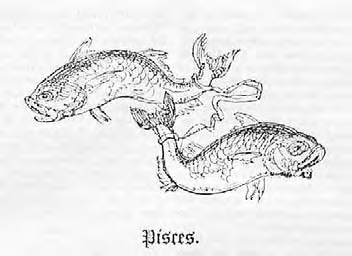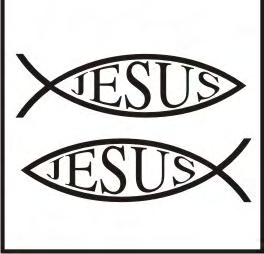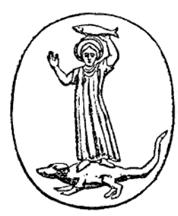38.
From 4300 B.C. to 2150 B.C., it was the Age of Taurus, the Bull. From 2150 B.C. to
1 A.D., it was the Age of Aries, the Ram, and from 1 A.D. to 2150 A.D. it is the Age of
Pisces, the age we are still in to this day, and in and around 2150, we will enter the
new age: the Age of Aquarius.
This information is readily available,279 although there remains a question as to when exactly these ages
begin and end, as there is a sort of ―no man‘s land‖ of a couple hundred years when the sun is between
constellations, so to speak. For example, estimates of when the Age of Pisces began range from 255 or
150 years BCE to 0 AD/CE.
39.
Now, the Bible reflects, broadly speaking, a symbolic movement through three
ages, while foreshadowing a fourth. In the Old Testament when Moses comes down
Mount Sinai with the 10 Commandments, he is very upset to see his people
worshipping a golden bull calf. In fact, he shattered the stone tablets and instructed
his people to kill each other in order to purify themselves. Most biblical scholars
would attribute this anger to the fact that the Israelites were worshipping a false idol,
or something to that effect. The reality is—the golden bull is Taurus the Bull, and
Moses represents the new Age of Aries the Ram. This is why Jews even today still
blow the Ram’s horn. (Jos 6:4) Moses represents the new Age of Aries, and upon the
new age, everyone must shed the old age. Other deities mark these transitions as
well, such as Mithra, a pre-Christian god who kills the bull, in the same symbology.
The stories of the golden bull calf (Exd 32:34) and the instruction to his people to kill each other in order
to purify themselves (Exd 32:27) are found in the biblical Book of Exodus. With regard to the Bull/Calf
symbolism as it relates to the Age of Taurus, along with the transition into the Age of Aries, the Ram,
Carpenter explains:
...the Precession of the Equinoxes caused the Sun, at its moment of triumph over the powers of
darkness, to stand at one period in the constellation of the Bull, and at a period some two
thousand years later in the constellation of the Ram. It was perfectly natural therefore that a
change in the sacred symbols should, in the course of time, take place; yet perfectly natural also
that these symbols, having once been consecrated and adopted, should continue to be honored
and clung to long after the time of their astronomical appropriateness had passed, and so to be
found side by side in later centuries....
279 See, e.g., ―Axial precession‖ and ―Age of Aquarius‖ on Wikipedia.

It is indeed easy to imagine that the change from the worship of the Bull to the worship of the
Lamb which undoubtedly took place among various peoples as time went on, was only a ritual
change initiated by the priests in order to put on record and harmonize with the astronomical
alteration. Anyhow it is curious that while Mithra in the early times was specially associated with
the bull, his association with the lamb belonged more to the Roman period. Somewhat the same
happened in the case of Attis. In the Bible we read of the indignation of Moses at the setting up
by the Israelites of a Golden Calf, after the sacrifice of the ram-lamb had been instituted—as if
indeed the rebellious people were returning to the earlier cult of Apis which they ought to have left
behind them in Egypt. In Egypt itself, too, we find the worship of Apis, as time went on, yielding
place to that of the Ram-headed god Amun, or Jupiter Ammon. So that both from the Bible and
from Egyptian history we may conclude that the worship of the Lamb or Ram succeeded to the
worship of the Bull.280
The association of the bull-slaying god Mithra with the sign or Age of Taurus the Bull was made by
Porphyry (c. 232/4-c. 305),281 and from the evidence it is clear he was repeating an older tradition. In
addition to Porphyry, ―the third-century church father Origen also confirms the importance to Mithraism of
the stars.‖282
Concerning Mithraism, philosophy professor Dr. David Ulansey says that ―recent work has raised the
possibility that Mithraic sanctuaries were used as astronomical observatories and that holes piercing the
walls and ceilings of the temples may have been placed for specific astronomical purposes.‖283
Dr. Ulansey also concludes:
...the Mithraists came to know about and attribute importance of the position of the celestial
equator as it was when the spring equinox was in Taurus... 284
As we have seen, the knowledge of the precession evidently dates back centuries before being formally
described in writing by Hipparchus in the second century BCE, and it appears that in Mithraism we
possess a clear vestige of myths and traditions developed during the Age of Taurus as well as centuries
280 Carpenter, 46-48.
281 Ulansey, 17.
282 Ulansey, 18.
283 Ulansey, 17.
284 Ulansey, 62.
afterward, in order to reflect the supposedly proper mythology for that time period. This point about
Mithra‘s relationship to Taurus is demonstrated quite well by Ulansey in his book The Origins of the
Mithraic Mysteries.
It is important to recall that these ―ages‖ are symbolic and do not represent exact periods. Moreover,
rather than being a chronicle of ―history‖ written by those who purportedly experienced it, the Old
Testament is a collection of stories compiled over a period of centuries. Scholars who claim the event is
historical put Exodus around the 15th century BCE. In turn, this date is used as an argument against the
above point under the supposition that the Exodus reflects true, literal history.
As we have seen, however, odds are there is relatively little real history in many of these biblical texts,
and these largely constitute fictional/allegorical stories. So, the argument that 1400 BCE is later in time
than the generalized beginning of the Age of Aries, which is around 2150 BCE (plus or minus a few
centuries), is not viable, because the ―real‖ biblical events simply cannot be proved to be historical, and
the texts concerning them were largely composed in the centuries after the Babylonian Exile (6th cent.
BCE), when Jewish priests evidently learned about Babylonian astrology. From earlier strata of these
texts, such as the Book of Job, it appears the Hebrews also knew the more rudimentary Chaldean star-
worship and astronomy as well.
40.
Now Jesus is the figure who ushers in the age following Aries, the Age of Pisces
or the Two Fish. Fish symbolism is very abundant in the New Testament. Jesus feeds
5,000 people with bread and “two fish.” When he begins his ministry walking along
Galilee, he befriends two fisherman, who follow him.
The motifs of Jesus miraculously feeding the crowd with two fish (Mt 14:17; Jn 6:9) and the two fishermen
(Mt 4:19) can be found in the New Testament. The gospel of John is loaded with fishy imagery, including
Jesus essentially establishing the fish as the symbol of the Christian age, when he emphasizes it in the
last chapter, after his Resurrection:
Jesus said to them, "Children, have you any fish?" They answered him, "No." (Jn 21:5)
The Greek word for fish is ΙΦΘΥΣ, which has been held since ancient times as a symbol of Jesus Christ,
thus further reinforcing the apparent astrological symbolism of Christianity, since we have been
astrological y in the Age of Pisces during the ―Christian era.‖ The fish symbol is therefore found all over
the place in Christian tradition: As another example, early Christians were called ―Pisciculi‖ or ―little
fishes.‖ As the Catholic Encyclopedia states: ―Among the symbols employed by the primitive Christians,
that of the fish ranks probably first in importance.‖285 In this regard, French historian and archaeologist Dr.
Adolphe Napoléon Didron says:
The fish, in the opinion of antiquarians in general, is the symbol of Jesus Christ... A fish is
sculptured upon a number of Christian monuments, and more particularly upon the ancient
sarcophagi... It is seen also upon medals bearing the name of our Saviour, and upon engraved
stones, cameos and intaglios, The fish is also to be remarked upon the amulets worn, suspended
from the neck by children, and upon ancient glasses and sepulchral lamps....
...Tertullian adds, ―We are little fishes in Christ our great fish.‖286
41.
And I think we’ve all seen the Jesus-fish on the backs of people’s cars. Little do
they know what it actually means. It is a Pagan astrological symbolism for the Sun’s
Kingdom during the Age of Pisces. Also, Jesus’ assumed birth date is essentially the
start of this age.
Concerning Jesus‘s connection to the astrological Age of Pisces, Carpenter comments:
Finally it has been pointed out...that in the quite early years of Christianity the Fish came in as an
accepted symbol of Jesus Christ. Considering that after the domination of Taurus and Aries, the
Fish ( Pisces) comes next in succession as the Zodiacal sign for the Vernal Equinox, and is now
285 CE, VI, 83.
286 Didron, 346-347.



the constellation in which the Sun stands at that period, it seems not impossible that the
astronomical change has been the cause of the adoption of this new symbol.287
Indeed, it is likewise important to point out that the LAMB too was associated with Jesus early on. This
fact represents a residual reference to the Age of Aries, while the Fish is the Age of Pisces, the next age
in the precession of the equinoxes. Coupled with the astrological symbolism in other parts of the Bible, it
would be logical to conclude that we are seeing more of the same here. Concerning this development,
Murdock remarks:
As Moses was created to usher in the Age of Aries, so was Jesus to serve as the Avatar of the
Age of Pisces, which is evident from the abundant fish imagery used throughout the gospel tale.
This zodiacal connection has been so suppressed that people with the fish symbol on the back of
their cars have no idea what it stands for, although they are fallaciously told it represents
―ICHTHYS,‖ as anagram for ―Jesus Christ, Son of God, Savior,‖ ichthys also being the Greek
word for fish.288
It is interesting to point out that the Egyptian god Horus was associated with the Fish as well, where
―Horus was portrayed as Ichthys with the fish sign over his head.‖289
Ancient Egyptian
engraving of the Gnostic
Horus, termed ―Jesus
Christ in the character of
Horus‖
(Massey, HJMC, 25)
Further clarification regarding the astrological poetry around Jesus may be found at John 14:2, which
says: ―In my father‘s house are many mansions.‖ The original Greek word is μοναὶ or monai, the singular
of which is defined by Strong‘s (G3438) as ―a staying, abiding, dwelling, abode,‖ while the Oxford
Classical Greek Dictionary includes the word ―mansion‖ in its definition. This odd saying has been
interpreted as a reference to the 12 signs or ―houses‖ of the zodiac.290
287 Carpenter, 48.
288 Acharya, CC, 146.
289 Massey, HJMC, 25.
290 In strict astrological parlance, the ―houses‖ differ from the signs; yet, they have ―the same boundaries as the
twelve signs in the chart.‖
42. At Luke 22:10 when Jesus is asked by his disciples where the last Passover will be,
Jesus replied: “Behold, when ye are entered into the city, there shall a man meet you
bearing a pitcher of water... follow him into the house where he entereth in.” This
scripture is by far one of the most revealing of all the astrological references. The
man bearing a pitcher of water is Aquarius, the water-bearer, who is always pictured
as a man pouring out a pitcher of water. He represents the age after Pisces, and when
the Sun, “God’s Sun,” leaves the Age of Pisces, “Jesus,” it will go into the House of
Aquarius, as Aquarius follows Pisces in the precession of the equinoxes. All Jesus is
saying is that after the Age of Pisces will come the Age of Aquarius.
Aquarius is Latin for ―water-bearer/carrier.‖ Its significance is summarized by Maxwell:
According to astrology, sometime after the year 2010, the Sun will enter His new Sign, or His new
Kingdom, as it was called by the ancients. This new coming Sign/Kingdom, soon to be upon us,
will be, according to the Zodiac, the House or Sign of Aquarius. So when we read in Luke 22:10,
we now understand why God‘s Sun states that He and His followers, at the last Passover, are to
go into ―the house of the man with the water pitcher.‖ So we see that in the coming millennium,
God‘s Sun will bring us into His new Kingdom or House of Aquarius (the man with the water
pitcher).291
Murdock likewise suggests that this pericope refers to the Aquarian Age:
…Jesus [evidently] makes mention of the precession of the equinoxes of the change of the ages
when he says to the disciples, who are asking about how to prepare for the ―Passover‖: ―Behold,
when you have entered the city, a man a carrying a pitcher of water will meet you; follow him into
the house which he enters…‖ (Lk 22:10) This famous yet enigmatic passage [ostensibly] refers to
the ―house‖ or Age of Aquarius, the Water-Bearer, and Jesus is instructing his disciples to pass
over into it.292
Combined with all the evidence we have seen regarding the astrology of the Bible and Christian tradition,
along with the astrotheology of much Pagan religion and mythology that Judaism and Christianity are
based on, these conclusions are logical and more scientific than believing fabulous biblical tales as either
―historical‖ or ―just made up.‖ In other words, the most scientific conclusion is not that various supernatural
motifs found in the New Testament tale are either ―factual‖ or simply fabricated on the spot by zealous
followers of an otherwise ―historical‖ Jesus: In reality, they are mythical, as found in the myths of
predecessor gods and goddesses, and possess astrotheological meaning as they did in those myths.
43.
Now, we have all heard about the end times and the end of the world. The
cartoonish depictions in the Book of Revelation aside, a main source of this idea
comes from Matthew 28:20, where Jesus says “I will be with you even to the end of
the world.” However, in the King James Version, “world” is a mistranslation, among
many mistranslations. The actual word being used is “aeon”, which means “age.” “I
will be with you even to the end of the age.” Which is true, as Jesus’ Solar Piscean
personification will end when the Sun enters the Age of Aquarius. The entire concept
of end times and the end of the world is a misinterpreted astrological allegory. Let’s
tell that to the approximately 100 million people in America who believe the end of the
world is coming.
As we have seen, Matthew 28:20 states: ―I wil be with you even to the end of the age.‖ The Greek word
―aion‖ or ―aeon‖ means ―age.‖ If God meant to say ―end of the world,‖ He would have used the Greek
word ―kosmos.‖ As it had been in previous editions such as the Bishop‘s Bible (1568), the word was
mistranslated as ―world‖ in the King James Bible but has been corrected to ―age‖ in the New King James
Version as well as several other more modern English translations. Jerome‘s Latin Vulgate translation
291 Maxwell, 43.
292 Acharya, CC, 146.

uses the word saeculum, which likewise means ―age,‖ among other meanings. The Latin word for ―world‖
is mundus.
Concerning this development, Massey remarks:
In the course of Precession, about 255 B.C., the vernal birthplace passed into the sign of the
Fishes, and the Messiah who had been represented for 2155 years by the Ram or Lamb, and
previously for other 2155 years by the Apis Bull, was now imaged as the Fish, or the ―Fish-man,‖
called Ichthys in Greek. The original Fish-man—the An of Egypt, and the Oan of Chaldea—
probably dates from the previous cycle of precession, or 26,000 years earlier; and about 255
B.C., the Messiah, as the Fish-man, was to come up once more as the Manifestor from the
celestial waters. The coming Messiah is called Dag, the Fish, in the Talmud; and the Jews at one
time connected his coming with some conjunction, or occurrence, in the sign of the Fishes! This
shows the Jews were not only in possession of the astronomical allegory, but also of the tradition
by which it could be interpreted.293
Regarding the strange imagery in the biblical book of Revelation, Dr. George A. Wells connects the figure
seven to the sun, moon and five planets that make up the days of the week:
Revelation‘s figuring the heavenly Jesus as a lamb with seven horns and seven eyes ―which are
the spirits of God sent forth into all the earth‖ (5:6) is a manifold reworking of old traditions. Horns
are a sign of power (Deuteronomy 33:17) and in Daniel designated kingly power. The seven eyes
which inform the lamb of is happening all over the earth seem to be residues from ancient
astrological lore...according to which God‘s eyes are the sun, the moon, and the five planets...294
The Book of Revelation is a highly astrotheological text, apparently depicting the Great Year or
Precession of Equinoxes. For more on this subject, see the chapter ―The Meaning of Revelation‖ in
Murdock‘s The Christ Conspiracy. Suffice it to say that the biblical Armageddon will only take place at all if
humanity brings it to pass by its own hand, especially by believing in this purported biblical blueprint.
44.
Furthermore, the character of Jesus, being a literary and astrological hybrid, is
most explicitly a plagiarization of the Egyptian sun god Horus. For example, inscribed
about 3,500 years ago, on the walls at the Temple of Luxor in Egypt are images of the
enunciation, the miracle conception, the birth, and the adoration of Horus. The
images begin with Thoth announcing to the virgin Isis that she will conceive Horus,
then Kneph the holy ghost impregnating the virgin, and then the virgin birth and the
adoration.
Regarding the birth scene of Amenhotep III at Luxor, Egyptologist Dr. Sharpe states:
In this picture we have the Annunciation, the Conception, the Birth, and the Adoration, as
described in the First and Second Chapters of Luke‘s Gospel; and as we have historical
assurance that the chapters in Matthew‘s Gospel which contain the Miraculous Birth of Jesus are
an after addition not in the earliest manuscripts, it seems probable that these two poetical
chapters in Luke may also be unhistorical, and be borrowed from the Egyptian accounts of the
miraculous birth of their kings.
293 Massey, Lectures, 7-8.
294 Wells, WWJ, 179.
Although his interpretations have been challenged, Murdock demonstrates several important aspects of
Sharpe‘s contentions to have a factual basis, and concludes:
Regardless of the order of the scenes, or the terminology used to describe elements thereof, the
fact remains that at the Temple of Luxor is depicted the conception upon a virgin by the highly
important father god, Amun, to produce a divine son. As we have seen, Amun‘s divine child in this
birth cycle is the ―bringer of salvation,‖ and this myth of the miraculous birth of the divine savior
likely was ―recorded of every Egyptian king,‖ making it highly noticeable long before the Christ
figure was ever conceived.
The Luxor nativity scene represents the birth sequence of an obviously very important god-king,
as it was depicted in one of the most famous Egyptian sites that endured for some 2,000 years.
Egypt, it should be kept in mind, was a mere stone‘s throw from the Israelite homeland, with a
well-trodden ―Horus road,‖ called in the ancient texts the ―Ways of Horus‖ or ―Way of Horus,‖
linking the two nations and possessing numerous Egyptian artifacts, including a massive, long-
lived fort and Horus temple at the site of Tharu, for instance. Moreover, at the time when
Christianity was formulated, there were an estimated 1 million Jews, Hebrews, Samaritans and
other Israelitish people in Egypt, making up approximately one-half of the important and influential
city of Alexandria. The question is, with all the evident influence from the Egyptian religion upon
Christianity that we have seen so far—and will continue to see abundantly—were the creators of
the Christian myth aware of this highly significant birth scene from this significant temple site in
Egypt? If not, these scenes were widespread enough right up to and into the common era—could
the creators of Christianity really have been oblivious to these images and the stories of royal
divine births they depict?295
An extensive discussion of this subject can be found in Murdock‘s article ―The Nativity Scene at Luxor‖
and in her book Christ in Egypt, pp. 167-194.
45.
This is exactly the story of Jesus’ miracle conception. In fact, the literary
similarities between the Egyptian religion and the Christian religion are staggering.
And the plagiarism is continuous. The story of Noah and Noah’s Ark is taken directly
from tradition. The concept of a Great Flood is ubiquitous throughout the ancient
world, with over 200 cited claims in different periods and times.
The existence of flood myths other than the biblical one is well known, as is the sensible suggestion that
Noah‘s Ark is a mythical tale.296 Regarding the flood, Barbara Walker states:
The biblical flood story, the ―deluge,‖ was a late offshoot of a cycle of flood myths known
everywhere in the ancient world. Thousands of years before the Bible was written, an ark was
built by the Sumerian Ziusudra. In Akkad, the flood hero‘s name was Atrakhasis. In Babylon he
was Uta-Napishtim, the only mortal to become immortal. In Greece he was Deucalion, who
repopulated the earth after the waters subsided [and after the ark landed on Mt. Parn








